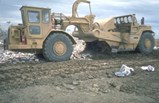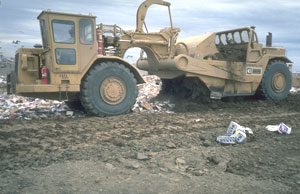Placing Cover Soil: Scraper vs. Dozer
 When it comes to placing cover soil, landfill managers can differ over which method is best: dozer or scraper.
When it comes to placing cover soil, landfill managers can differ over which method is best: dozer or scraper.
No question about it, the first time I saw a scraper covering waste, I was impressed. It was a Caterpillar 637. And as I watch it "shoot the slopes," I found it hard to argue with its performance--700 hp...75,000 pounds of soil... 20 seconds from can to cover. That was production!
The view of that scraper dive-bombing the face became a reference point. That was 1983. Covering direct with scrapers became the standard by which other methods were rated. For some time I believed that there just was no faster way to cover waste. And as anyone worth their salt knows: "faster is cheaper" ...or so I thought.
Then in 1985, something happened. I don't recall if the scraper broke down or just ran out of time at the end of the day. But the cell was only half covered, and the scraper couldn't finish it. We were stuck. Then one of the operators suggested that, with the dozer, he might be able to scalp enough soil from what had been placed to somehow cover the rest of the cell.

With no other choice, we reluctantly said, "OK." Surprisingly, in about 30 minutes, the cell was completely covered. It was trimmed, graded, and smooth. It looked Great!
Somebody said, "Wow, we couldn't have done it any faster with the scraper."
We began conducting a series of tests to compare the scraper versus the dozer for covering. Here's a simplified example:
Covering with a dozer requires the following resources...
|
Scraper |
0.8 hr (@ $125/hr) = |
$100 |
|
Dozer |
0.6 hr (@ $100/hr) = |
$60 |
|
Airspace |
80 cy (@$10/cy) = |
$800 |
|
|
|
$960 |
Covering with a scraper requires the following resources...
|
Scraper |
1.2 hrs (@ $125/hr) = |
$150 |
|
Dozer |
|
|
|
Airspace |
120 cy ($10/cy) = |
$1200 |
|
|
|
$1350 |
These were the results in 1985. They are the results now.
It was a little hard to face, but covering direct with a scraper was (is) not quicker ...or cheaper. Today, after performing scores of landfill audits, I've yet to see an example where the scraper did best.
In general, a scraper will use 1/3 to 2/3 more soil than a dozer. A scraper cannot maintain grade as it rocks and rolls down a slope of garbage. The bowl must be kept well above the surface of the garbage so that it doesn't hook onto objects (like mattresses). The front tires of the scraper also create giant ruts that must be filled with soil.
A dozer on the other hand, builds its own solid platform of soil as it covers, and it provides much more control in terms of grading soil.
So, if you're into horsepower, noise, and drama, go ahead and cover with the scrapers. But if efficiency and economics are your game, keep that scraper off the garbage and start spreading soil with your dozer.
If you're still skeptical--good! Independent thinkers make good managers.
But just for fun, perform your own analysis. For a week, cover direct with the scraper. Count loads and keep track of total machine time. Keep track of other expenses too (such as tires).
Then calculate the total cost associated with this method--including airspace, machine time, and labor.
For the next week have the scraper dump the soil at the edge of the cell and use the dozer to spread it. Again, track the time and money. At the end of this second week, do your own comparison.
I bet it's the dozer from then on.
Neal Bolton, a registered engineer, author of "The Handbook of Landfill Operations," and principal of Blue Ridge Services, provides operational consulting for landfills in the U.S. and abroad. He can be reached at blueridge@blueridgeservices.com.
